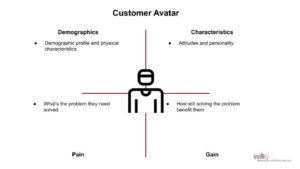A powerful content marketing strategy for your social media can be the catalyst that propels your business from online obscurity to standout success. With a clear, actionable game plan, you can create engaging content that brings value to your audience and builds value in your business.
Over my seven years as a small business owner, my biggest struggle was marketing. With a small budget, I didn’t have the resources to hire a big agency. I was lost in the sea of choices! I watched every YouTube video I could about digital marketing and followed all the people on social media with whom I felt I resonated. Through this, I was able to identify several key factors that separate the pretty noise from the social media that creates value for my customers and my business.
Table of contents
- Craft Your Content Marketing Strategy for Peak Performance on Social Media
- Creating a Consistent Brand Voice on The Social Media Platform: Building a Relationship with Your Customers
- Develop a Content Calendar to Streamline Your Content Marketing Strategy
- Measuring and Adapting Your Content Marketing Strategy with Social Media Analytics: Watering the Flowers and Pruning the Weeds
- Social Media Community Engagement Builds a Loyal Audience and Value for Your Business.
- Content Marketing Strategy for Better Social Media – Final Thoughts
Now, let’s dig into the thing that will most impact your social media efforts: the strategy.
Craft Your Content Marketing Strategy for Peak Performance on Social Media
An effective digital presence is the result of a well-crafted content marketing strategy. It acts as a blueprint for your message, guiding your brand’s narrative on the noisy stages of various social platforms.
Whether you aim to increase brand awareness, drive sales, or build customer relationships, aligning your content marketing efforts with your overall business goals is paramount. Your social media marketing plan implements your content marketing strategy. It is the vehicle that gets you to your destination.
So, let’s take a look at what’s involved.
To build your social media marketing plan:
- Define your business objectives.
- Create your best customer avatar.
- Map your buyer’s journey.
- Develop strategies and tactics aligned with your objectives.
- Determining the channels you will focus on.
- Analyze, optimize, and repeat what worked.
These steps will help you create a marketing plan that delivers value to your customers and prospects and establishes you as a subject matter expert in your field on social media.
Defining Your Social Media Objectives: Why Are You Posting On Social Media
Setting your social media goals will pinpoint the coordinates for your digital journey. These targets should be SMART—specific, measurable, achievable, relevant, and time-bound—to chart a clear course toward success. Whether you seek to build your email list with lead-generation tactics, increase brand awareness, or drive website traffic, your social media marketing goals should reflect the pulse of your business objectives.
The goals you determine will be the light at the end of the tunnel. They are where you want to go and your strategy is the pathway that you are going to follow to get there. The tactics you decide on are the steps you are going to take to move along that pathway. The goals, strategy, and tactics are all connected.
Your Best Customer Avatar Defines The People Who Want (and Need) What You Have to Offer.
Creating your best customer avatar means knowing the following:

- Who your best customer is
- What are their demographic profile and physical characteristics
- What are their attitudes and personality
- What is the problem they need to solve
- How will your products or services solve their problem
Your best customer is not the person who comes every couple of weeks or months to buy this or that or jump on a call here and there. Your best customers are 20% of your customer base but provide 80% of your revenue. Review your sales data to see who is spending the most in your business and how often and how recently they’ve purchased. This is called an RFM analysis, and it’s key to understanding who’s driving your business forward.
Knowing your audience is like understanding the language of a foreign land—it enables you to communicate effectively and create engaging and relevant content that resonates. To chart this territory, employ a blend of research tactics. You can:
- Conduct surveys to gather information through your social media or email marketing.
- Have conversations with your best customers to understand their needs, challenges, and motivations.
- Use social media analytics to understand the demographics and interests of your followers and engaged audience.
Developing audience personas, guided by this data, assists you in building campaigns that are sharply focused on and will resonate with your best customer segments. You can gain insights into audience demographics, behaviors, and preferences, which will improve your content marketing.
Understand Why Your Customers Purchase and How You Can Support Their Decision Within Your Content Marketing Strategy
Mapping your buyer’s journey is about putting yourself in your best customer’s shoes. It is key to understand the pathway they are on. A customer will not see your marketing if they do not have a need for what you are providing, no matter how good it is. They are not going to see you until they need you. Once they become aware that they have a problem that needs to be solved, they will start considering their choices. Once they see there are several choices, they will start weighing the choices they have to solve their problem. Then, they will make a decision. While building your best customer avatar, keep these questions in mind:
- How did they discover you?
- Once they discover your business, what can you provide them to build trust in you?
- How will you tell them you can help solve their problem?
- How does your service or product benefit them when solving their problem?
The answers to these questions will assist you when developing your marketing content. Using your best customer avatar, you can create valuable content that will support the buyer’s journey. It should guide them to their decision, making the purchase of your product the next logical step. The content will serve as pit stops along their pathway. Having your customers’ perspectives in mind will guide the tactics and strategy you develop. This will take your content from just pretty images and captions to “ah-ha moments” for your target audience.
Developing a Game Plan to Meet Your Business Goals: Knowing Your How and Why in Your Content Marketing Strategy
You have your goal, you did your audience research, and you know the pathway your best customers will take to solve their problems. Now, you need to create an action plan that will assist you in achieving the goals you defined.

Effective strategies vary widely depending on your goals. There are some universal approaches that can be adapted to fit most situations. For instance, implementing a content marketing strategy can enhance visibility and establish field authority. This entails creating engaging social media content that speaks directly to your audience’s needs and pain points in a way that resonates with them.
Another powerful strategy would be a lead generation strategy. This could be sharing a simple checklist for your customers to follow about the topic you specialize in, a free ebook, or an exclusive discount on your services. This will not only attract potential customers but also help build trust and credibility with them.
Focus on the Channels Where Your Best Customers Play
Choosing social channels is a crucial decision that should reflect the habits and inclinations of your best customer avatar. It’s not just about being present; it’s about being present where your audience is most attentive and receptive. Different social networks host different audience segments, and an effective social media strategy uses the networks where your audience thrives.
Some popular social media platforms to consider are:
- Instagram: known for its visual storytelling prowess, usually a younger crowd
- LinkedIn: a platform for professional networking and sharing
- Facebook: a versatile social media platform with an older audience demographic
- Pinterest: a platform for visual inspiration and discovery with a younger female audience
- YouTube: a video-sharing platform with a large user base
Review your best customer avatar and launch your strategy on the channel where your target audience is showing up. Each platform offers unique opportunities to connect with your audience, so it’s important to choose the ones that align with your goals and target audience.
For small businesses, the focus should be on the platforms that offer the most significant impact while remaining manageable within their content creation capabilities. You do not have to be on every platform to be successful.Let me repeat that. You DO NOT have to be on every social media platform to be successful. Establishing a clear tactic for the social media channels you choose is essential to ensure strategic alignment with your goals.
Creating a Consistent Brand Voice on The Social Media Platform: Building a Relationship with Your Customers

A consistent brand voice is a harmonizing element that blends your business’s personality and tone across all digital marketing. It’s what makes your brand instantly recognizable, fostering a seamless customer experience that strengthens brand recognition and loyalty.
Your brand voice must:
- Be distinctive yet adaptable
- Stay in tune with market trends and the evolving preferences of your audience.
Your brand voice requires continuous monitoring and fine-tuning to maintain an effective dialogue with your audience.
Visuals and messaging need to be in sync, echoing across all your digital marketing channels and underlining your brand’s identity and values. This consistency is important when your customers visit your website, they know they are in the right place. Continuing this consistency crafts a compelling narrative that captivates your audience and underscores the message that your brand is not just a mere participant in the market but an authority in your field.
Harmonizing Visuals and Messaging
Visual content is fundamental on platforms like Instagram, where brand identity is often conveyed through a vibrant array of images and videos. Harmonizing your brand’s visuals and messaging across different social media channels is critical to reinforcing brand recognition and personality. This goes beyond mere logo placement; it’s about ensuring that every piece of content, whether a reel or a story, aligns with the overarching narrative of your brand.
Utilizing hashtags and keywords effectively can also serve as a unifying thread, weaving together individual posts into a cohesive brand story that encourages audience interaction. This harmonization creates a symphony of visuals and messaging that resonates with followers, amplifying your brand’s voice amid the social media cacophony.
Crafting Compelling Content Narratives

The skill of creating captivating content narratives hinges on the ability to consistently engage followers, spinning a tale that maintains their interest over time. In today’s digital marketplace, audiences crave authenticity and content that transparently reflects business practices and values. Incorporating long-form storytelling into your content strategy will draw your audience into your content. Long-form content is engaging, and the detailed narratives showcase the heart of your brand.
Repurposing existing content, such as customer reviews or blog posts, can be a strategic move, but the quality of content—not just frequency—must take center stage. A compelling narrative invites your audience to embark on a memorable journey with your brand, one that fosters a deep, lasting connection. Maintaining the consistent message and brand voice in combination with consistent sharing of the content you create, will amplify your marketing efforts.
Develop a Content Calendar to Streamline Your Content Marketing Strategy

A social media content calendar forms the structure of a disciplined and well-thought-out approach to your online presence. It’s a meticulous plan that outlines what to share, when to share it, and on which platform—ensuring a steady stream of content that keeps your audience engaged and informed. The purpose of this calendar is to plot out your social media activities, allowing for a balanced distribution of content that provides value to your audience and your business.
Creating a social media content calendar assists you when creating your content and executing your plan. It provides an overview of what captions or images need to be created and by when. This allows you to plan ahead and create your content efficiently. For example, you could do all your topic and keyword research on Monday, then on Tuesday create all your captions, and so on. Creating your content in bulk will allow you to be more efficient with your time.
Posting When Your Audience is Active Boosts Engagement and Impact
Scheduling your posts for maximum impact involves knowing the rhythm of your audience’s online activity. Each social platform has its own prime time for social posts and engagement:
- Facebook peaks mid-week from 1 pm to 3 pm
- Instagram during lunch hours and evenings
- LinkedIn on weekdays around 10 am
By scheduling content when your audience is most active, you amplify the potential for engagement, driving more meaningful interactions and fostering a deeper connection with your brand. As each audience is different, you should review engagement metrics on each platform to see when your audience is most active. The most common times individuals are active on social media may not be the same for your target audience.
Automation tools can be a maestro’s wand in this symphony, conducting the release of your content to align with maximum engagement at these optimal times. Utilizing scheduling tools like Metricool and Later, ensures that your message appears at a moment when it’s most likely to be heard, maximizing the reach and impact of your social media posts.
Balancing Content Types
Striking a balance among multiple platforms and content types is crucial to sustaining audience interest and stimulating interaction. From interactive elements like audience questions and polls to long-form video content, the variety in your content portfolio can significantly boost user participation and engagement. This balance ensures that your audience remains captivated by your brand’s narrative, with each post contributing to a larger, more engaging story.
Your social media marketing plan should carefully consider the mix of content types, ensuring that each post offers value and sustains the interest of your followers. It’s about striking the right chord with your audience, creating a library of content that resonates and reverberates across the social media landscape.
Measuring and Adapting Your Content Marketing Strategy with Social Media Analytics: Watering the Flowers and Pruning the Weeds

Social media metrics tell you what you should do more of and what needs to be tossed in the garbage. Metrics allow you to monitor your progress towards specific goals, such as driving website traffic or increasing your brand awareness. Reviewing your metrics will ensure you are creating content that captivates your audience by providing you with feedback on the types of content that get the most engagement.
Metrics such as:
- clicks
- comments
- reach
- engagement rates
- impressions
- video watch time
provide a detailed understanding of top-performing content and overall audience engagement.
Regular analysis involves utilizing tools that track detailed engagement metrics (like UTM codes). This step is critical for refining your social media strategy in real time. A continuous measuring, learning, and adapting process keeps your execution agile and effective in the ever-changing social media landscape.
Use KPIs and Performance Tracking to Optimize Your Social Media Strategy
Establishing KPIs and monitoring performance involves converting your social media efforts into quantifiable results. Metrics such as:
- Email subscriber growth rate
- Website traffic
- Total time viewed on a video
- Etc.
When you establish clear key performance indicators, you create a framework for assessing the impact of your social media strategy and ensure that it remains in harmony with your overall marketing objectives. This keeps your strategy in tune, and you make informed decisions that will amplify your brand’s digital presence.
Metrics offer insights into the effectiveness of your social media efforts. These indicators help sharpen your strategy by highlighting what is working and what is not, guiding your marketing efforts toward success.
Create Maximum Impact with Data-Driven Strategies
Understanding your metrics will lead to better decision making, which will lead to business growth. Using and learning how to read your analytics in tools like Google Analytics 4, Instagram Professional Dashboard or Metricool, are like having the answers to a test.
For instance, I use Instagram’s Professional Dashboard to monitor the total watch time of a video I posted. Based on this information, I can see when viewers stopped watching, allowing me to understand what engages my audience and what doesn’t.
In Google Analytics 4, I utilize UTM codes on our posts, and I am able to see what platforms are driving the most traffic to our website. Is it Instagram or Pinterest? Whichever one is working the best, we do more of it.
With Metricool, I can see a full array of metrics. Here I can review impressions on all our posts, organic engagement, watch time and so much more. Also, I can compare my posts all in one location and see what my audience likes and engages with. I can also see website traffic here and do a competitor analysis against my content.
Social Media Community Engagement Builds a Loyal Audience and Value for Your Business.
Connecting with your social media community involves:
- Fostering a conversation that connects with your audience and mirrors your brand voice
- Providing content that addresses your audience’s needs and provides value
- A mix of reactive and proactive engagement practices, such as responding to interactions and initiating conversations
- Showing your brand’s human side through personal interactions and addressing audience feedback
These practices enhance social media engagement and foster deeper connections with your community.After all, it is called social media, so part of your strategy should involve being social.
Acknowledging those interacting with your organic content is crucial for guiding more individuals through the marketing funnel and increasing audience awareness and respect. Collaborating with other businesses or creators in your social media tactics can amplify your brand’s message and further solidify your social presence.

Encouraging User Participation
Promoting user participation involves creating a space where your audience can actively interact with your brand. A specific engagement strategy that fosters user participation is crucial for driving up engagement rates on your social platforms. Some key tactics to consider include:
- Soliciting audience feedback
- Encouraging active participation through questions in your captions
- Creating interactive polls or surveys
- Responding to comments and messages in a timely manner
- Going live and answering questions on the platform
By implementing these strategies, you can reinforce the connection between your brand and your audience, increasing engagement and brand loyalty.
Proactive user engagement and feedback solicitation reinforce brand voice consistency, strengthening the audience’s rapport. This engagement facilitates a two-way conversation that can drive traffic to your platforms and contribute to follower growth. Whether through compelling content or interactive posts, encouraging participation is about making each follower feel heard and valued, strengthening the bond they share with your brand.
Managing Customer Interactions
Handling customer interactions involves cultivating an atmosphere that appreciates each individual’s experience with your brand. Prompt responses to customer interactions can lead to increased customer satisfaction, as personalized care on social media is increasingly preferred by consumers. Metrics like average reply time and response volume help evaluate the effectiveness of social customer care, ensuring that your social team is meeting the expectations of your audience.
Addressing negative comments and attempting to regain trust is also critical to managing online interactions. You can use a content moderation platform to handle such engagements. This proactive approach to customer care reinforces the perception of your brand as attentive and responsive, essential for maintaining a positive image and fostering customer loyalty.
Content Marketing Strategy for Better Social Media – Final Thoughts
In conclusion, taking the time to create a customer-centric content strategy for your social media marketing plan will create value for your customers and your business, boosting your engagement and revenue.
Your marketing plan needs to have a clear goal (with quantifiable expectations).
We talked about strategy and how it aligns to achieve that goal.
We reviewed the tactics you can have in place that support the strategy.
Keeping your best customer avatar in mind while creating your tactics (your content going on your social media) and choosing your channel, will result in increased engagement and impact across your business.
And, be social on social media! Engage with your audience, other businesses, and creators. To build brand loyalty and recognition, you must think of your social media as a two-way conversation. Be proactive, and not just reactive.
How to Write Better Headlines
Discover 10 tips to craft compelling headlines that captivate readers and boost engagement.
Mastering Relationship Marketing: 5 Principles for Building Lasting Customer Connections
A practical exploration of relationship marketing.
B2B Content Marketing—Boost Your Impact with 5 Proven Copywriting Frameworks
Five copywriting frameworks to boost your B2B content marketing.
Author: Bonnie Conrad
Bonnie, a military spouse, has worked in both the public and private sectors throughout her career. Leaving the corporate world behind, she started her own small business and struggled with digital marketing. Determined to overcome this, she immersed herself in digital marketing. The dedication allowed her to pinpoint key factors distinguishing superficial content from valuable social media strategies that truly benefit customers and businesses. Bonnie’s clients appreciate her honest, no-frills feedback.
Use this link to book a meeting time with Bonnie.


